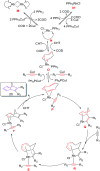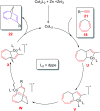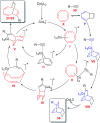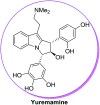Transition metal catalyzed [6 + 2] cycloadditions
- PMID: 35530050
- PMCID: PMC9070306
- DOI: 10.1039/c9ra02839k
Transition metal catalyzed [6 + 2] cycloadditions
Abstract
The [6 + 2] cycloaddition reactions are one of the important synthetic transformations to construct eight membered carbo-/heterocyclic systems. The present review is an attempt to update readers on transition metal catalyzed [6 + 2] cycloaddition reactions of various 6π-contributing substrates such as cycloheptatrienes (CHT), cyclooctatetrenes (COTT), allenals, vinylcyclobutanones, fulvene etc. employing rhodium, cobalt, titanium, copper, platinum, ruthenium, rhenium and diphenylprolinolsilyl ethers etc. as catalysts. The transition metal catalyzed [6 + 2] cycloaddition reactions with a variety of functionalized substrates provide straightforward access to eight membered cyclic and/or 5/8, 6/8 etc. condensed carbo-/heterocyclic molecules in moderate to good yields.
This journal is © The Royal Society of Chemistry.
Conflict of interest statement
There are no conflicts to declare.
Figures









































Similar articles
-
Rhodium-Catalyzed (5 + 2) and (5 + 1) Cycloadditions Using 1,4-Enynes as Five-Carbon Building Blocks.Acc Chem Res. 2020 Jan 21;53(1):231-243. doi: 10.1021/acs.accounts.9b00477. Epub 2019 Dec 10. Acc Chem Res. 2020. PMID: 31820914 Free PMC article. Review.
-
Rhodium-catalyzed [5 + 2 + 1] cycloaddition of ene-vinylcyclopropanes and CO: reaction design, development, application in natural product synthesis, and inspiration for developing new reactions for synthesis of eight-membered carbocycles.Acc Chem Res. 2015 Aug 18;48(8):2288-96. doi: 10.1021/acs.accounts.5b00037. Epub 2015 Jul 31. Acc Chem Res. 2015. PMID: 26227886
-
Mechanistic Studies of Transition-Metal-Catalyzed [2 + 2 + 2] Cycloaddition Reactions.Chem Rev. 2021 Feb 10;121(3):1894-1979. doi: 10.1021/acs.chemrev.0c00062. Epub 2020 Jul 30. Chem Rev. 2021. PMID: 32786426
-
The [3 + 3]-cycloaddition alternative for heterocycle syntheses: catalytically generated metalloenolcarbenes as dipolar adducts.Acc Chem Res. 2014 Apr 15;47(4):1396-405. doi: 10.1021/ar5000055. Epub 2014 Mar 20. Acc Chem Res. 2014. PMID: 24650430 Free PMC article.
-
Transition-Metal-Catalyzed Cycloaddition Reactions to Access Seven-Membered Rings.Chemistry. 2020 Dec 1;26(67):15354-15377. doi: 10.1002/chem.202002713. Epub 2020 Oct 22. Chemistry. 2020. PMID: 32705722 Review.
Cited by
-
Synthesis of Functionally Substituted Bicyclo[4.2.1]nona-2,4-dienes and Bicyclo[4.2.1]nona-2,4,7-trienes by Cobalt(I)-catalyzed [6π + 2π] Cycloaddition of 2-Tropylcyclohexanone.ACS Omega. 2020 Nov 24;5(48):31440-31449. doi: 10.1021/acsomega.0c05072. eCollection 2020 Dec 8. ACS Omega. 2020. PMID: 33324856 Free PMC article.
-
Valence-isomer selective cycloaddition reaction of cycloheptatrienes-norcaradienes.Nat Commun. 2024 Mar 14;15(1):2309. doi: 10.1038/s41467-024-46523-1. Nat Commun. 2024. PMID: 38485991 Free PMC article.
References
-
- Advances in Cycloaddition, ed. D. P. Curran, JAI Press, Greenwich, 1994, vol. 1–3
- Trost B. M. Angew. Chem., Int. Ed. Engl. 1995;34:259. doi: 10.1002/anie.199502591. - DOI
- Lautens M. Klute W. Tam W. Chem. Rev. 1996;96:49. doi: 10.1021/cr950016l. - DOI - PubMed
- Schore N. E. Chem. Rev. 1988;88:1081. doi: 10.1021/cr00089a006. - DOI
-
-
[5+2] cycloaddition references see:
- Pellissiera H. Adv. Synth. Catal. 2011;353:189. doi: 10.1002/adsc.201000695. - DOI
-
and reference cited therein
-
Publication types
LinkOut - more resources
Full Text Sources

